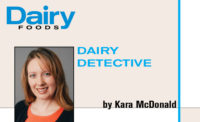Extensive dairy ingredient nutrition research — supported by the Dairy Research Institute (which is supported by the dairy checkoff) —continues to showcase numerous benefits while meeting the growing nutritional needs of an aging population who desire new ways to maintain an active, independent lifestyle. The opportunity exists for U.S. dairy ingredient suppliers to help food and beverage formulators create products which target these needs.
“The nutritional benefits and improved functionality of dairy ingredients have created fertile ground for our industry to grow U.S. dairy sales here and abroad,” said Vikki Nicholson, senior vice president, global marketing at the U.S. Dairy Export Council, Arlington, Va. “The time is now to leverage the value that U.S. dairy brings to the global marketplace.”
According to a United Nations’ report, an unprecedented shift in demographics is now taking place around the globe “without parallel in the history of humanity.” The report indicates that by 2050, for the first time ever, the number of people more than 60 years old will exceed the total number of those under the age of 15 years. In that timeframe, the number of people 60+ will increase by a staggering 600 million.
Domestically, U.S. baby boomers are hitting retirement age and creating a wave that in 40 years will more than double the number of Americans age 65+, according to the Alliance for Aging Research, Washington, D.C. By 2050, the 65-and-older age group is projected to increase to 88.5 million, more than doubling the 2008 number of 38.7 million. Similarly, according to the U.S. Census Bureau, the 85-and-older population is expected to more than triple between 2008 and 2050, growing from 5.4 million to 19 million people.
The prevalence of chronic disease within this senior population has already resulted in increased U.S. national health care spending and high rates of disability. The problem only stands to worsen as the percentage of elderly population grows.
Buying power
With such size and projected buying power, this aging population is exhibiting a greater demand for aging-related services and products — more so than previous generations. Research indicates that baby boomers are displaying interest in purchasing a variety of products and services including preventative medicines, brand-name drugs and healthier foods to contribute to their future well-being.
Never before has there been greater potential to market healthy foods and beverages to an aging population as the mature consumer strives to stay fit, active and independent. According to recent consumer insights, 70% of the adult population believes proper nutrition delays the onset of chronic disease. In addition, a vast body of scientific research continues to mount indicating that dairy ingredients play a valuable role in foods and beverages for the maturing consumer group.


